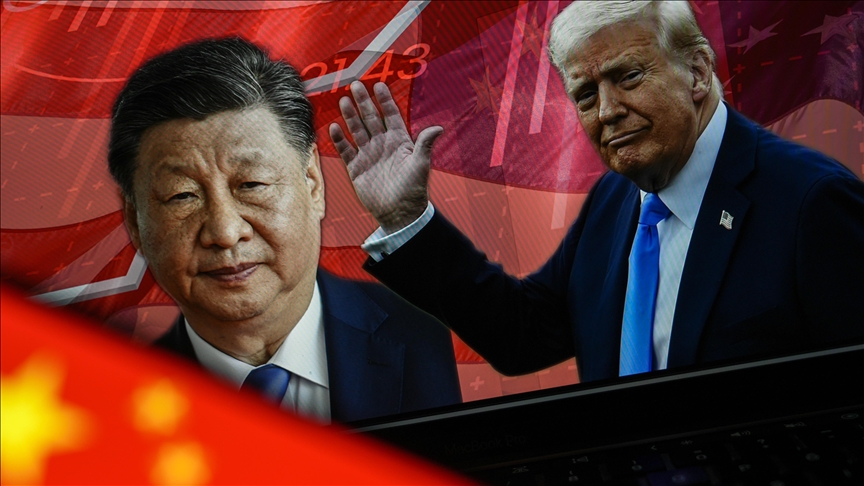FACTBOX - How dominant is China in the global rare earths industry?
On the heels of massive US tariffs, China’s recent export curbs on 7 rare earth elements expose a key US vulnerability: near-total dependence on Beijing for critical materials powering tech and defense

- China controls 69% of global rare earth output and 90% of processing, while the US relies on imports for 80% of rare earths and is still years away from reducing this dependence
ISTANBUL
Just two days after US President Donald Trump announced his sweeping “Liberation Day” tariffs, China flexed a powerful economic muscle of its own: its near-total dominance over rare earth elements.
In response to the tariffs that have since risen to 145%, Beijing imposed export controls on seven critical minerals used in everything from smartphones to jet engines: samarium, gadolinium, terbium, dysprosium, lutetium, scandium, and yttrium.
Since April 4, companies have needed to acquire special approval from China’s Commerce Ministry to export these elements at any stages of the supply chain ranging from raw extraction to finished products.
International trade rules allow China to do this as these materials count as “dual-use” products — materials that can serve both civilian and military purposes — but the restriction of their trade is still expected to have a significant impact for the US supply.
What are rare earth elements and why do they matter?
Rare earth elements are a group of 17 chemically similar materials critical to modern technology. Despite the name, most are abundant in the Earth’s crust — but they are called “rare” because they are rarely found in pure form and are costly and polluting to extract.
Rare earths are used in a wide range of products: smartphones, electric vehicles, wind turbines, LED lights, medical devices, and military hardware. They are typically classified into light, medium, and heavy categories.
Light rare earth elements comprise of lanthanum, cerium, praseodymium, neodymium, samarium, europium.
But, most of the metals on China’s list, are in the medium — gadolinium, yttrium, terbium, and dysprosium — and heavy variety, which include holmium, erbium, thulium, ytterbium, lutetium. Further, they are primarily used in defense, energy, and automotive industries, crucial sectors for the US.
Rare earth elements are crucial for many advanced US defense technologies, including F-35 fighter jets, Virginia and Columbia-class submarines, Tomahawk missiles, radar systems, Predator unmanned aerial vehicles, and Joint Direct Attack Munition smart bombs.
For instance, each F-35 fighter jet contains over 900 pounds (400 kg) of REEs. An Arleigh Burke-class DDG-51 destroyer requires approximately 5,200 pounds (2,358 kg), while a Virginia-class submarine uses around 9,200 pounds (4,173 kg), according to the Center for Strategic and International Studies.
How China came to dominate the rare earth market
China controls roughly 69% of global rare earth production and nearly 90% of processing capacity, according to the US Geological Survey’s 2024 data. It also holds about 49% of the world’s 90 million tons of known reserves of rare earth elements.
Its closest competitor, Brazil, houses only 21 million tons, while India has 6.9 million, Australia 5.7 million tons, Russia, 3.8 million tons, and Vietnam with 3.5 million tons. Meanwhile, the US, Greenland, and Tanzania each account for 2% of global rare earth reserves.
China can produce all of the 17 REEs on the periodic table ever since it discovered its first and largest reserve in 1927 in the Inner Mongolia Autonomous Region
Its main production hub, the Bayan Obo mine in Inner Mongolia, accounts for nearly 84% of China’s total reserves and 38% of global reserves and 83.7% of China’s.
This dominance is no accident. Beijing has been making strategic investments for decades, while following lenient environmental policies that undercut competitors on both cost and scale.
How dependent is the US?
The US relies entirely on imports for certain rare earths. It has 100% import dependence on yttrium, with 93% coming from China. It also has an 80% import dependence for all rare earth compounds and metals, 56% of which are sourced from China.
The Center for Strategic and International Studies (CSIS) says China accounted for 99% of heavy rare earth processing globally. Until 2023, a refinery in Vietnam provided a minimal alternative — but it was shut down in 2024 due to a tax dispute, leaving China with an effective monopoly over supply.
As a result, there are currently no viable import alternatives for four of the seven minerals on China’s restricted list: dysprosium, terbium, yttrium, and lutetium.
To reduce its reliance the US has also started taking steps to boost rare earth production.
In its 2024 National Defense Industrial Strategy, the Pentagon set a goal to establish a complete a comprehensive supply chain by 2027, especially for its defense industry needs. Since 2020, it has invested over $439 million toward that aim.
MP Materials received $9.6 million to build a light rare earth separation facility in California and another $35 million in 2022 for a heavy rare earths processing plant — both the first of their kind in the US.
Still, production of neodymium-praseodymium (NdPr) oxide was miniscule compared to China in 2024, according to CSIS.
Lynas USA, a subsidiary of Australia’s Lynas Rare Earths, also received more than $150 million in US government support to build separation facilities. In January 2025, USA Rare Earths produced its first sample of dysprosium oxide, but the achievement remains lab-scale.
Despite these moves, experts say the US remains years away from scaling up to meet domestic needs and reducing dependence on China.
Anadolu Agency website contains only a portion of the news stories offered to subscribers in the AA News Broadcasting System (HAS), and in summarized form. Please contact us for subscription options.







